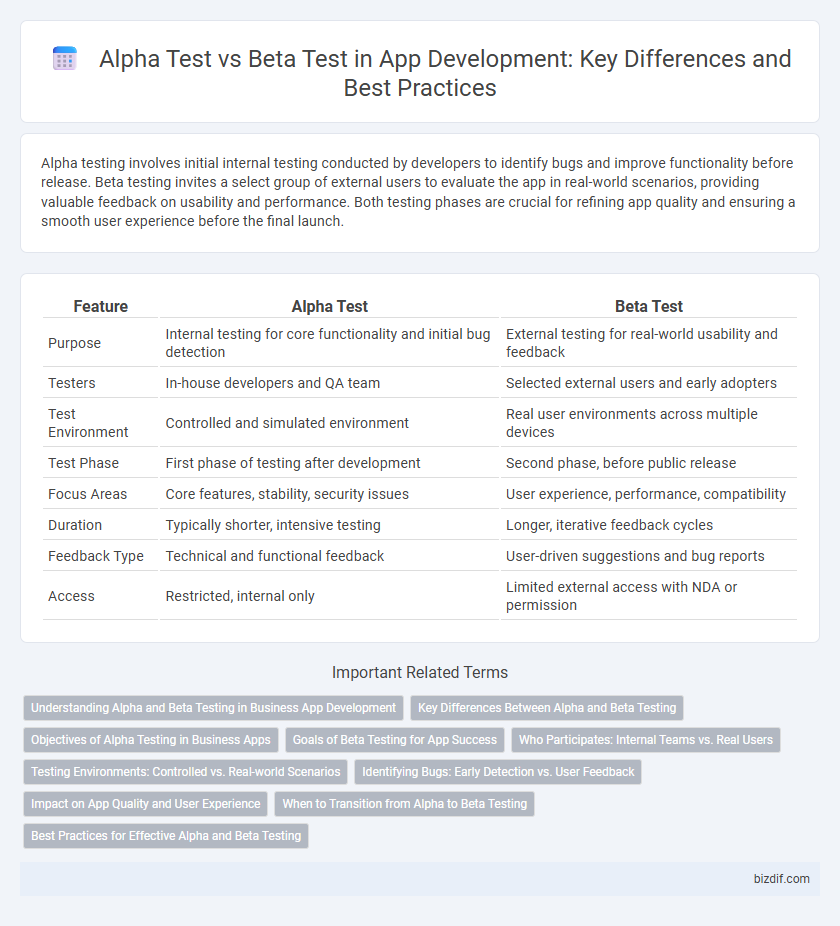Alpha testing involves initial internal testing conducted by developers to identify bugs and improve functionality before release. Beta testing invites a select group of external users to evaluate the app in real-world scenarios, providing valuable feedback on usability and performance. Both testing phases are crucial for refining app quality and ensuring a smooth user experience before the final launch.
Table of Comparison
| Feature | Alpha Test | Beta Test |
|---|---|---|
| Purpose | Internal testing for core functionality and initial bug detection | External testing for real-world usability and feedback |
| Testers | In-house developers and QA team | Selected external users and early adopters |
| Test Environment | Controlled and simulated environment | Real user environments across multiple devices |
| Test Phase | First phase of testing after development | Second phase, before public release |
| Focus Areas | Core features, stability, security issues | User experience, performance, compatibility |
| Duration | Typically shorter, intensive testing | Longer, iterative feedback cycles |
| Feedback Type | Technical and functional feedback | User-driven suggestions and bug reports |
| Access | Restricted, internal only | Limited external access with NDA or permission |
Understanding Alpha and Beta Testing in Business App Development
Alpha testing involves internal team members rigorously evaluating a business app to identify bugs and usability issues before external exposure. Beta testing releases the app to a select group of real users outside the development team, gathering valuable feedback on performance, user experience, and potential improvements. Distinguishing these phases ensures comprehensive quality assurance and user-centric refinement in business app development.
Key Differences Between Alpha and Beta Testing
Alpha testing occurs internally within the development team to identify bugs and usability issues before the product reaches real users, often involving white-box testing techniques and controlled environments. Beta testing follows alpha testing and is conducted externally by a limited group of real users in a real-world environment to gather feedback on functionality, performance, and user experience. The key differences lie in the testing environment, tester profile, objectives, and the stage of the software development lifecycle where each test is performed.
Objectives of Alpha Testing in Business Apps
Alpha testing in business app development primarily aims to identify critical bugs and usability issues before releasing the product to external testers. This phase focuses on validating core functionalities, ensuring the app meets specified business requirements and user expectations. Early detection of performance bottlenecks and security vulnerabilities during alpha testing helps mitigate risks and improves overall software quality.
Goals of Beta Testing for App Success
Beta testing aims to identify real-world usability issues and gather user feedback to enhance app performance and user experience before official release. It focuses on detecting bugs that were not found during alpha testing and evaluates the app's compatibility across diverse devices and environments. The goal of beta testing is to validate app stability, functionality, and market readiness, ensuring higher user satisfaction and reducing post-launch problems.
Who Participates: Internal Teams vs. Real Users
Alpha testing involves internal teams such as developers, QA specialists, and product managers who rigorously evaluate the app within a controlled environment to identify bugs and usability issues. Beta testing engages real users outside the development team to assess the app's performance, gather user feedback, and uncover issues that occur in diverse real-world conditions. This distinction ensures comprehensive quality assurance by combining expert scrutiny with authentic user experiences.
Testing Environments: Controlled vs. Real-world Scenarios
Alpha testing occurs within a controlled environment where developers and internal testers identify initial bugs and usability issues, ensuring app stability before external exposure. Beta testing takes place in real-world scenarios with actual users, providing diverse feedback on performance, compatibility, and user experience under varied conditions. This phased approach enhances app quality by balancing controlled troubleshooting with practical, real-world validation.
Identifying Bugs: Early Detection vs. User Feedback
Alpha testing identifies bugs through controlled, internal developer evaluations, enabling early detection of critical issues before public exposure. Beta testing gathers user feedback from a broader audience, revealing usability problems and real-world performance bugs that internal teams may overlook. Combining alpha test precision with beta test diversity enhances overall app stability and user experience.
Impact on App Quality and User Experience
Alpha testing involves internal teams identifying critical bugs early, significantly enhancing app stability and functionality before public exposure. Beta testing engages real users in diverse environments, providing valuable feedback that improves user experience and uncovers usability issues missed during alpha. Together, these phases optimize app quality by refining performance and ensuring the app meets user expectations prior to full release.
When to Transition from Alpha to Beta Testing
Transition from alpha to beta testing occurs once the app achieves stable core functionality with most critical bugs resolved and internal testing confirms feature completeness. This phase shift prioritizes exposing the app to a broader audience, typically external testers, to identify usability issues, performance bottlenecks, and unexpected errors across diverse environments. Effective criteria for progressing include meeting predefined quality metrics, ensuring key features operate as intended, and internal feedback indicating readiness for real-world usage scenarios.
Best Practices for Effective Alpha and Beta Testing
Alpha testing, conducted in-house by developers and QA teams, focuses on identifying critical bugs and usability issues in early app versions to ensure core functionality stability. Beta testing involves a broader audience outside the development team, gathering real-world user feedback on performance, compatibility, and user experience across diverse devices and network conditions. Best practices include defining clear test objectives, using structured feedback tools, prioritizing critical issue resolution, and maintaining open communication channels to iterate quickly and enhance app quality before final release.
Beta test vs Alpha test Infographic

 bizdif.com
bizdif.com